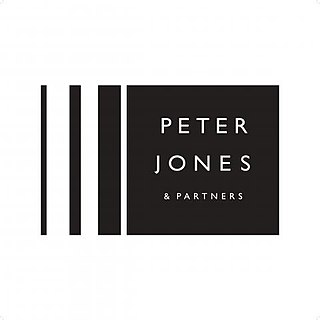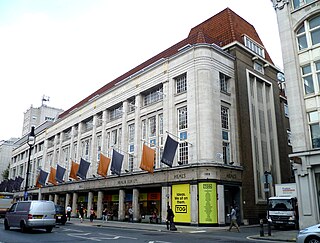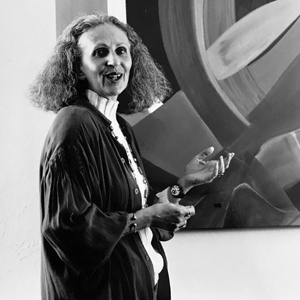
The Jubilee line is a London Underground line that runs between Stanmore in suburban north-west London and Stratford in east London, via the Docklands, South Bank and West End. Opened in 1979, it is the newest line on the Underground network, although some sections of track date back to 1932 and some stations to 1879.

Daniel Libeskind is a Polish-American architect, artist, professor and set designer. Libeskind founded Studio Daniel Libeskind in 1989 with his wife, Nina, and is its principal design architect.

Albertopolis is the nickname given to the area centred on Exhibition Road in London, named after Prince Albert, consort of Queen Victoria. It contains many educational and cultural sites. It lies in the former village of Brompton in Middlesex, renamed as South Kensington, split between the Royal Borough of Kensington and Chelsea and the City of Westminster, and the area bordered by Cromwell Road to the south and Kensington Road to the north.

Imperial War Museum North is a museum in the Metropolitan Borough of Trafford in Greater Manchester, England. One of five branches of the Imperial War Museum, it explores the impact of modern conflicts on people and society. It is the first branch of the Imperial War Museum to be located in the north of England. The museum occupies a site overlooking the Manchester Ship Canal on Trafford Wharf Road, Trafford Park, an area which during the Second World War was a key industrial centre and consequently heavily bombed during the Manchester Blitz in 1940. The area is now home to the Lowry cultural centre and the MediaCityUK development, which stand opposite the museum at Salford Quays.

The Serpentine Galleries are two contemporary art galleries in Kensington Gardens, Westminster, Greater London. Recently rebranded to just Serpentine, the organisation is split across Serpentine South, previously known as the Serpentine Gallery, and Serpentine North, previously known as the Sackler Gallery. The gallery spaces are within five minutes' walk of each other, linked by the bridge over the Serpentine Lake from which the galleries get their names. Their exhibitions, architecture, education and public programmes attract up to 1.2 million visitors a year. Admission to both galleries is free. The CEO is Bettina Korek, and the artistic director Hans Ulrich Obrist.
Jonathan Glancey, is an architectural critic and writer who was the architecture and design editor at The Guardian, a position he held from 1997 to February 2012. He previously held the same post at The Independent. He also has been involved with the architecture magazines Building Design, Architectural Review, The Architect and Blueprint. He is an honorary fellow of the Royal Institute of British Architects, RIBA.
Arup is a British multinational professional services firm headquartered in London that provides design, engineering, architecture, planning, and advisory services across every aspect of the built environment. It employs about 17,000 people in over 90 offices across 35 countries, and has participated in projects in over 160 countries.

Not to be confused with Peter Jones

Heal's is a British furniture retail company comprising seven stores, selling a range of furniture, lighting and home accessories. In 2001, a guide published in association with the Victoria & Albert Museum wrote that for over two centuries Heal's had been known for promoting modern design and for employing talented young designers.

Cecil Balmond OBE is a Sri Lankan–British designer, artist, and writer. In 1968 Balmond joined Ove Arup & Partners, leading him to become deputy chairman. In 2000 he founded design and research group, the AGU.

The Felix Nussbaum Haus is a museum in Osnabrück, Germany, which houses the paintings of German-Jewish painter Felix Nussbaum. The building also houses an exhibition space, which focuses on racism and intolerance.

Hélène Binet is a Swiss-French architectural photographer based in London, who is also one of the leading architectural photographers in the world. She is most known for her work with architects Daniel Libeskind, Peter Zumthor and Zaha Hadid, and has published books on works of several architects.

The Hempel Hotel was a luxury 5-star hotel in London, England. It was located at 31-35 Craven Hill Gardens to the north of Hyde Park off Bayswater Road. It was a small boutique hotel with Zen inspiration, designed by Anouska Hempel. The design of each of the 40 rooms and 10 apartments centered on minimalistic art and the colour white, and it also featured a zen garden.

The ArcelorMittal Orbit is a 114.5-metre (376-foot) sculpture and observation tower in the Queen Elizabeth Olympic Park in Stratford, London. It is Britain's largest piece of public art, and is intended to be a permanent lasting legacy of London's hosting of the 2012 Summer Olympic and Paralympic Games, assisting in the post-Olympics regeneration of the Stratford area. Sited between the Olympic Stadium and the Aquatics Centre, it allows visitors to view the whole Olympic Park from two observation platforms.
The Ito-Balmond Serpentine Pavilion is a structure designed by Cecil Balmond and Toyo Ito and originally built for the Serpentine Gallery Pavilion programme in London's Kensington Gardens, Hyde Park, in 2002 and now part of a restaurant in southern France. It focuses on modern and contemporary art. Each year the Serpentine Gallery builds a temporary structure for the summer in its grounds, and projects are led by director Julia Peyton-Jones. The Ito-Balmond Serpentine Pavilion has been hailed as one of the most successful temporary pavilions to date. Jonathan Glancey, architecture critic for the UK's The Guardian, called it "one of the most exquisite and revolutionary buildings of recent times." The design is based on an algorithm designed by Balmond. "Although fun to look at, this structure was rooted in complex geometry…the pavilion had no façade and no hidden structural frame behind it… what you saw was 100% pure structure, its holistic beauty like that of a crystal or a snowflake." Balmond was awarded the Gengo Matsui Prize for the pavilion, one of the highest awards for engineering given in Japan. The pavilion now serves as the beach club restaurant of a luxury hotel in Le Beauvallon, across the bay from Saint-Tropez in southern France. Ito and Balmond have since collaborated on the Taichung Opera House in Taiwan.
Jannuzzi Smith is a design studio founded in 1993 by Michele Jannuzzi (1967) and Richard Smith (1967) in London. They now have offices in London and Lugano, Switzerland.
Marsyas is a 150-meter-long, ten storey high sculpture designed by Anish Kapoor and Cecil Balmond. It was on show at Tate Modern gallery, London in 2003 and was commissioned as part of the Unilever Series. Marsyas was the third in a series of commissions for Tate Modern’s Turbine Hall and the first to make use of the entire space.

Barbara Weil, was an artist from the United States, who showed relationships between painting, sculpture, contemporary architecture and the human being in unusual ways in her work. In collaboration with Daniel Libeskind, she created the architecturally significant Studio Weil in Majorca. The building contains work and exhibition spaces of the artist.
The year 2014 in architecture involved some significant architectural events and new buildings.

Gareth Dale Hoskins OBE was a Scottish architect.














